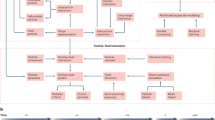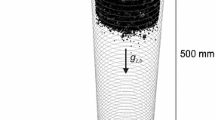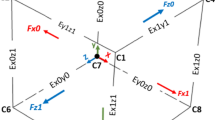Abstract
The discrete element method (DEM) is a well-established approach to study granular materials in numerous fields of application; each granular particle is modelled individually to predict the overall behaviour. This behaviour can be then extracted by averaging, or coarse graining, the sample using a suitable method. The choice of appropriate coarse-graining method entails a compromise between accuracy and computational cost, especially in the large-scale simulations typically required by industry. A number of coarse-graining methods have been proposed in the literature, and these are reviewed and categorized in this work. Within this contribution, two novel porosity coarse-graining strategies are proposed including a voxel method where a secondary dense grid of “pixel cells” is implemented adopting a binary logic for the coarse graining and a hybrid method where both analytical formulas and pixels are utilized. The proposed methods are compared with four coarse-graining schemes that have been documented in the literature, including the particle centroid method, an analytical method, a method which solves the diffusion equation and an approach which employs averaging using kernels. The novel methods are validated for problems in both two and three dimensions through comparison with the “accurate” analytical method. It is shown that, once validated, both the proposed schemes can approximate the exact solutions quite accurately; however, there is a high computational cost associated with the voxel method. The accuracy of both methods can be adjusted allowing the user to decide between accuracy and computational time. A detailed comparison is then presented for all six schemes considering “accuracy”, “smoothness” and “computational cost”. Optimal parameters are obtained for all six methods, and recommendations for coarse-graining DEM samples are discussed.


















Similar content being viewed by others
Availability of data and materials
Supporting data are available on request: please contact moriska@mail.ntua.gr.
Abbreviations
- \(a,{ }b,{ }c\) :
-
Distances between the particle centroid and each bin face
- \(A_{{{\text{cap}}}}\) :
-
Area of disc cap
- \(A_{i}\) :
-
Disk segment area \(i\)
- b :
-
Bandwidth (width of averaging kernel)
- \({\text{CFD}}\) :
-
Computational fluid dynamics
- \({\text{Cu}}\) :
-
Coefficient of uniformity
- \(D\) :
-
Diffusion coefficient
- \({\text{DEM}}\) :
-
Discrete element method
- \(d_{{\text{p}}}\) :
-
Particle diameter
- \(d_{{{\text{coarse}}}}\) :
-
Coarse particle diameter
- \(d_{{{\text{fine}}}}\) :
-
Fine particle diameter
- \(F_{{{\text{fine}}}}\) :
-
Fines content (%)
- \(G\) :
-
Shear modulus
- \(h\) :
-
Disk segment height
- \(n\) :
-
Porosity
- \({\text{No}}_{{\text{Eulerian-cells }}}\) :
-
Number of Eulerian cells
- \(N_{{\text{p}}}\) :
-
Number of particles
- \({\text{PCM}}\) :
-
Particle centroid method
- \({\text{Pi}}\) :
-
Number of pixels along each direction of the sample
- \({\text{PPM}}\) :
-
Particle meshing method
- \(r_{{\text{p}}}\) :
-
Particle radius
- \(t\) :
-
Time
- \(V_{{{\text{cap}}}}\) :
-
Spherical cap volume
- \(V_{{{\text{cell}}}}\) :
-
Eulerian cell volume
- \(V_{{{\text{edge}}}}\) :
-
Overlapping edge volume
- \(V_{{\text{p}}}\) :
-
Particle volume
- \(V_{{{\text{segm}}}}\) :
-
Particle segment volume
- \(X\) :
-
Multiplier that controls the Eulerian cell size
- \({\varvec{x}}\) :
-
Vector containing coordinates of Eulerian cell centroids
- \(x_{{\text{c}}} , y_{{\text{c}}}\) :
-
Coordinates of particle centroid
- \({\varvec{x}}_{{{\text{c}},k}}\) :
-
Vector containing coordinates of particle centroid
- \(a\) :
-
Magnitude of diffusion coefficient
- \(\Delta s\) :
-
Fluid cell size
- \(\Delta x\) :
-
Fluid cell size (x-dimension)
- \(\Delta y\) :
-
Fluid cell size (y-dimension)
- \(\Delta z\) :
-
Fluid cell size (z-dimension)
- \(\varepsilon^{p}\) :
-
Particle volume fraction
- \(\zeta_{{i,{\text{cell}}}} \) :
-
Coefficient of volume fraction
- \(\mu\) :
-
Interparticle friction coefficient
- \(\nu\) :
-
Poisson’s ratio
- \(\rho\) :
-
Particle density
References
O’Sullivan C, Bray DJ, Li S (2003) A new approach for calculating strain for particulate media. Int J Numer Anal Methods Geomech 27:859–877. https://doi.org/10.1002/nag.304
Guo N, Zhao J (2016) 3D multiscale modeling of strain localization in granular media. Comput Geotech 80:360–372. https://doi.org/10.1016/j.compgeo.2016.01.020
Kafui KD, Thornton C, Adams M (2002) Discrete particle-continuum fluid modelling for gas–solid fluidised beds. Chem Eng Sci 57:2395–2410. https://doi.org/10.1016/S0009-2509(02)00140-9
Xu BH, Yu AB (1997) Numerical simulation of the gas–solid flow in a fluidized bed by combining discrete particle method with computational fluid dynamics. Chem Eng Sci 52:2785–2809. https://doi.org/10.1016/S0009-2509(97)00081-X
Itasca Consulting Group Inc (2008) Particle flow code in 3 dimensions CCFD add-on. Itasca Consulting Group Inc.
Smith ER, Heyes DM, Dini D, Zaki TA (2012) Control-volume representation of molecular dynamics. Phys Rev E 85:56705. https://doi.org/10.1103/PhysRevE.85.056705
Hirsch C (2007) Numerical computation of internal and external flows: the fundamentals of computational fluid dynamics. Numer Comput Intern Extern Flows Fundam Comput Fluid Dyn. https://doi.org/10.1016/B978-0-7506-6594-0.X5037-1
Kloss C, Goniva C, Hager A et al (2012) Models, algorithms and validation for opensource DEM and CFD–DEM. Prog Comput Fluid Dyn 12:140–152. https://doi.org/10.1504/PCFD.2012.047457
Zhao J, Shan T (2013) Coupled CFD–DEM simulation of fluid–particle interaction in geomechanics. Powder Technol 239:248–258. https://doi.org/10.1016/j.powtec.2013.02.003
Kawaguchi T, Sakamoto M, Tanaka T, Tsuji Y (2000) Quasi-three-dimensional numerical simulation of spouted beds in cylinder. Powder Technol 109:3–12. https://doi.org/10.1016/S0032-5910(99)00222-3
Tsuji Y, Kawaguchi T, Tanaka T (1993) Discrete particle simulation of two-dimensional fluidized bed. Powder Technol 77:79–87. https://doi.org/10.1016/0032-5910(93)85010-7
Hoomans BPB, Kuipers JAM, Briels WJ, van Swaaij WPM (1996) Discrete particle simulation of bubble and slug formation in a two-dimensional gas-fluidised bed: a hard-sphere approach. Chem Eng Sci 51:99–118. https://doi.org/10.1016/0009-2509(95)00271-5
Darmana D, Deen NG, Kuipers JAM (2005) Detailed modeling of hydrodynamics, mass transfer and chemical reactions in a bubble column using a discrete bubble model. Chem Eng Sci 60:3383–3404. https://doi.org/10.1016/j.ces.2005.01.025
Tomiyama A, Žun I, Higaki H et al (1997) A three-dimensional particle tracking method for bubbly flow simulation. Nucl Eng Des 175:77–86. https://doi.org/10.1016/S0029-5493(97)00164-7
Khawaja HA, Scott SA, Virk MS, Moatamedi M (2012) Quantitative analysis of accuracy of voidage computations in CFD–DEM simulations. J Comput Multiph Flows 4:183–192. https://doi.org/10.1260/1757-482X.4.2.183
Lätzel M, Luding S, Herrmann HJ (2000) Macroscopic material properties from quasi-static, microscopic simulations of a two-dimensional shear-cell. Granul Matter 2:123–135. https://doi.org/10.1007/s100350000048
Fries L, Antonyuk S, Heinrich S, Palzer S (2011) DEM–CFD modeling of a fluidized bed spray granulator. Chem Eng Sci 66:2340–2355. https://doi.org/10.1016/j.ces.2011.02.038
Peng Z, Moghtaderi B, Doroodchi E (2016) A modified direct method for void fraction calculation in CFD–DEM simulations. Adv Powder Technol 27:19–32. https://doi.org/10.1016/j.apt.2015.10.021
Gui N, Fan J, Luo K (2008) DEM–LES study of 3-D bubbling fluidized bed with immersed tubes. Chem Eng Sci 63:3654–3663. https://doi.org/10.1016/j.ces.2008.04.038
Radl S, Gonzales BC, Goniva C, Pirker S (2015) State of the Art in Mapping Schemes for Dilute and Dense Euler-Lagrange Simulations. In: Progress in Applied CFD. SINTEF Academic Press, pp 103–112
Hobbs A (2009) Simulation of an aggregate dryer using coupled CFD and DEM methods. Int J Comut Fluid Dyn 23:199–207. https://doi.org/10.1080/10618560802680971
Boyce CM, Holland DJ, Scott SA, Dennis JS (2014) Novel fluid grid and voidage calculation techniques for a discrete element model of a 3D cylindrical fluidized bed. Comput Chem Eng 65:18–27. https://doi.org/10.1016/j.compchemeng.2014.02.019
Clarke DA, Sederman AJ, Gladden LF, Holland DJ (2018) Investigation of void fraction schemes for use with CFD–DEM simulations of fluidized beds. Ind Eng Chem Res 57:3002–3013. https://doi.org/10.1021/acs.iecr.7b04638
Fitzgerald BW, Zarghami A, Mahajan VV et al (2019) Multiscale simulation of elongated particles in fluidised beds. Chem Eng Sci X 2:100019. https://doi.org/10.1016/j.cesx.2019.100019
Mahajan VV, Nijssen TMJ, Kuipers JAM, Padding JT (2018) Non-spherical particles in a pseudo-2D fluidised bed: Modelling study. Chem Eng Sci 192:1105–1123. https://doi.org/10.1016/j.ces.2018.08.041
Mahajan VV, Padding JT, Nijssen TMJ et al (2018) Nonspherical particles in a pseudo-2D fluidized bed: experimental study. AIChE J 64:1573–1590. https://doi.org/10.1002/aic.16078
Mema I, Mahajan VV, Fitzgerald BW, Padding JT (2019) Effect of lift force and hydrodynamic torque on fluidisation of non-spherical particles. Chem Eng Sci 195:642–656. https://doi.org/10.1016/j.ces.2018.10.009
Wu CL, Zhan JM, Li YS et al (2009) Accurate void fraction calculation for three-dimensional discrete particle model on unstructured mesh. Chem Eng Sci 64:1260–1266. https://doi.org/10.1016/j.ces.2008.11.014
Bnà S, Manservisi S, Scardovelli R et al (2015) Numerical integration of implicit functions for the initialization of the VOF function. Comput Fluids 113:42–52. https://doi.org/10.1016/j.compfluid.2014.04.010
Freireich B, Kodam M, Wassgren C (2010) An exact method for determining local solid fractions in discrete element method simulations. AIChE J 56:3036–3048. https://doi.org/10.1002/aic.12223
Weinhart T, Thornton AR, Luding S, Bokhove O (2012) From discrete particles to continuum fields near a boundary. Granul Matter 14:289–294. https://doi.org/10.1007/s10035-012-0317-4
Babic M (1997) Average balance equations for granular materials. Int J Eng Sci 35:523–548. https://doi.org/10.1016/S0020-7225(96)00094-8
Glasser BJ, Goldhirsch I (2001) Scale dependence, correlations, and fluctuations of stresses in rapid granular flows. Phys Fluids 13:407–420. https://doi.org/10.1063/1.1338543
Goldhirsch I (2010) Stress, stress asymmetry and couple stress: from discrete particles to continuous fields. Granul Matter 12:239–252. https://doi.org/10.1007/s10035-010-0181-z
Weinhart T, Thornton AR, Luding S, Bokhove O (2012) Closure relations for shallow granular flows from particle simulations. Granul Matter 14:531–552. https://doi.org/10.1007/s10035-012-0355-y
Weinhart T, Hartkamp R, Thornton AR, Luding S (2013) Coarse-grained local and objective continuum description of three-dimensional granular flows down an inclined surface. Phys Fluids 25:70605. https://doi.org/10.1063/1.4812809
Weinhart T, Labra C, Luding S, Ooi JY (2016) Influence of coarse-graining parameters on the analysis of DEM simulations of silo flow. Powder Technol 293:138–148. https://doi.org/10.1016/j.powtec.2015.11.052
Imole OI, Krijgsman D, Weinhart T et al (2016) Reprint of “Experiments and discrete element simulation of the dosing of cohesive powders in a simplified geometry.” Powder Technol 293:69–81. https://doi.org/10.1016/j.powtec.2015.07.052
Roy S, Scheper BJ, Polman H et al (2019) Surface flow profiles for dry and wet granular materials by particle tracking velocimetry: the effect of wall roughness. Eur Phys J E 42:14. https://doi.org/10.1140/epje/i2019-11778-x
Weinhart T, Orefice L, Post M et al (2020) Fast, flexible particle simulations—an introduction to MercuryDPM. Comput Phys Commun 249:107129. https://doi.org/10.1016/j.cpc.2019.107129
Zhu HP, Yu AB (2002) Averaging method of granular materials. Phys Rev E 66:021302. https://doi.org/10.1103/PhysRevE.66.021302
Sun R, Xiao H (2015) Diffusion-based coarse graining in hybrid continuum–discrete solvers: applications in CFD–DEM. Int J Multiph Flow 72:233–247. https://doi.org/10.1016/j.ijmultiphaseflow.2015.02.014
Ries A, Brendel L, Wolf DE (2014) Coarse graining strategies at walls. Comput Part Mech 1:177–190. https://doi.org/10.1007/s40571-014-0023-6
Simonsen AS, Deen NG, Sørensen K et al (2019) Trajectory integrated smoothening of exchange fields for discrete phase simulations. Comput Fluids 186:15–23. https://doi.org/10.1016/j.compfluid.2019.03.015
Sun R, Xiao H (2015) Diffusion-based coarse graining in hybrid continuum–discrete solvers: Theoretical formulation and a priori tests. Int J Multiph Flow 77:142–157. https://doi.org/10.1016/j.ijmultiphaseflow.2015.08.014
Jing L, Kwok CY, Leung YF, Sobral YD (2016) Extended CFD–DEM for free-surface flow with multi-size granules. Int J Numer Anal Methods Geomech 40:62–79. https://doi.org/10.1002/nag.2387
Link JM, Cuypers LA, Deen NG, Kuipers JAM (2005) Flow regimes in a spout–fluid bed: a combined experimental and simulation study. Chem Eng Sci 60:3425–3442. https://doi.org/10.1016/j.ces.2005.01.027
Ouyang J, Li J (1999) Particle-motion-resolved discrete model for simulating gas–solid fluidization. Chem Eng Sci 54:2077–2083. https://doi.org/10.1016/S0009-2509(98)00413-8
van Wachem BGM, van der Schaaf J, Schouten JC et al (2001) Experimental validation of Lagrangian–Eulerian simulations of fluidized beds. Powder Technol 116:155–165. https://doi.org/10.1016/S0032-5910(00)00389-2
Strobl S, Formella A, Pöschel T (2016) Exact calculation of the overlap volume of spheres and mesh elements. J Comput Phys 311:158–172. https://doi.org/10.1016/j.jcp.2016.02.003
Xiao H, Sun J (2011) Algorithms in a robust hybrid CFD–DEM solver for particle-laden flows. Commun Comput Phys 9:297–323. https://doi.org/10.4208/cicp.260509.230210a
Richards WA (1995) The common content of a sphere and a regular tetrahedron having a common centre. Int J Math Educ Sci Technol 26:257–266. https://doi.org/10.1080/0020739950260211
Harris JW, Stöcker H (1998) Handbook of mathematics and computational science. Springer
Kalderon M (2017) A fundamental assessment of computational porosity. MSc thesis, Imp Coll London. https://doi.org/10.5281/zenodo.4436747
Fourier JBJ (1822) Théorie analytique de la chaleur. Chez Firmin Didot, père et fils
MATLAB (2010) version 7.10.0 (R2010a). The MathWorks Inc., Natick, Massachusetts
Summersgill F (2009) The use of particulate discrete element modelling to assess the vulnerability of soils to suffusion. MEng thesis, Imperial College London
Plimpton S (1995) Fast parallel algorithms for short-range molecular dynamics. J Comput Phys 117:1–19. https://doi.org/10.1006/JCPH.1995.1039
Shire T (2014) Micro-scale modelling of granular filters. PhD Thesis, Imperial College London
Hertz H (1882) Ueber die Berührung fester elastischer Körper. J Reine Angew Math 92:156–171
Mindlin R (1949) Compliance of elastic bodies in contact. Trans ASME J Appl Mech 16:259–268
Acknowledgements
Dr. Edward Smith was funded by EPSRC grant EP/P010393/1 as well as by the embedded CSE programme of the ARCHER UK National Supercomputing Service (http://www.archer.ac.uk). He would also like to acknowledge support under both the Distributed and Embedded Computational Science and Engineering Program (dCSE and eCSE, respectively). Original DEM data were generated by Ms. Freya Summersgill and Dr. Thomas Shire.
Author information
Authors and Affiliations
Corresponding author
Ethics declarations
Conflict of interest
The authors declare that they have no conflict of interest.
Rights and permissions
About this article
Cite this article
Kalderon, M., Smith, E. & O’Sullivan, C. Comparative analysis of porosity coarse-graining techniques for discrete element simulations of dense particulate systems. Comp. Part. Mech. 9, 199–219 (2022). https://doi.org/10.1007/s40571-021-00402-4
Received:
Revised:
Accepted:
Published:
Issue Date:
DOI: https://doi.org/10.1007/s40571-021-00402-4




